|
 Nederlands /
Dutch Nederlands /
Dutch
Animals in the garden
In
2007 I have started to describe the animals in the garden. Many insects
have their own page. I don't describe all animals. For example no birds. At the bottom of the page I have links to insect sites.
Frogs
|
Edible
Frog, green frog (Rana
esculenta).
They live on the bank of our pond. Green
frogs hibernate in the mud at the bottom of ponds or ditches over the winter and
wake up in spring, when the weather warms up.
In this case in the pond.
On
the third photo a young frog in April.
They eat insects, but also larvae, slugs and worms.
Edible frogs and common frogs deposit their eggs in big
lumps. Edible frogs are later (the end of May
to early June) First they eat a lot, when they are waked up.
Distribution: In Europe from
the Mediterranean area to Southern
Scandinavia. In the Netherlands the population has decreased.
German: Teichfrosch French: Grenouille verte
|
Common
frog (Rana
temporaria).
The common frog breeds in ponds in March, April. Throughout the summer
months they will range far from their breeding ponds and may be found
almost anywhere in our garden.
Today (5 March 2007) my woman discovered a frog in a bucket with rain
water. Normally it is not easy to make photos. So first I have taken some
photos, before it got its freedom again.
The common frog is the most widespread frog in Europe. They only
hibernate, when it gets very cold. You
may encounter the Common Frog from late February to early October. They eat the same food as the edible fog.
On 1 April (no joke) we saw the first frogspawn in the pond. Left under
you also see eggstrings of
the Common
Toad (Bufo bufo).
On 3-11 I saw the last common frog. It looked well-fed. What is
necessary of course to hibernate. Its colour is light green now.
They always have a dark patch behind their eyes.
German: Grasfrosch French: Grenouille
|
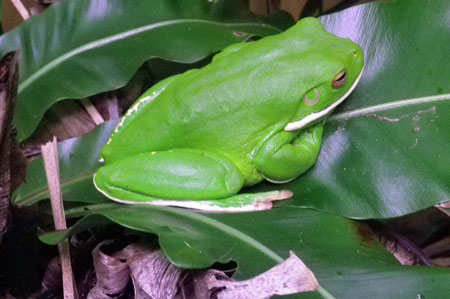 |
The white-lipped tree frog, the giant tree
frog (Litoria infrafrenata). The world's largest tree frog.
Native to the rainforests of North Queensland, New Guinea, the Bismarck Islands and the Admiralty Islands.
But what does this tree frog on a Dutch garden site? My wife had sent
photos of our frogs in the pond to her brother George, who lives near Cairns in Australia. He
sent back a photo of this frog, which he had taken in his garden. He thought it was
something for my garden site. Well ..... We were so proud on our frogs. This frog can be 13 cm.
The tree frog (Hyla arborea) is the only species that occurs in Netherlands. Not in our neighborhood. This rare
frog is only 4 or 5 cm.
 Our Common frogs in 2013. Photo 17-4-2013.
Our Common frogs in 2013. Photo 17-4-2013.
|
Newts
Smooth
Newt, Common
Newt (Triturus
vulgaris) It’s a small newt. It
is found throughout Europe and lives
in a large part of Europe (except in Spain, southern France and far north)
It’s the most northern living newt specie, because it is found in Norway
and Sweden. In the Netherlands it is most widespread newt. From April to June (the
breeding season)
they are in the pond, afterwards they go on land. The adults also
hibernate on land.
Today (5 March 2007) I have found smooth newts in the water meter
box (dry). Every year smooth
newts hibernate in the box. They seem always very thin. Especially if you
compare them with a salamander, which I had found the same day in small
pond, which I was cleaning. One newt I had almost forgotten. On the photo
you can see why. (mimicry) The belly is orange with dark spots. You can
see, if you lay them on their back. They played dead on this photo.
During the breeding season they develop a wavy crest; continuous from head
to tail.
German: Teichmolch
French: Triton ponctué, lobé, vulgaire |
Toads
-4kle.jpg)
|
|
Common Toad (Bufo bufo)
Family true toads
or Bufonidae.You can read more about it on wikipedia.
I was (11 March. 2007) working at
the compost heap, when I saw the common toad hidden in the heap. I have
taken some photos, before the toad disappeared again in the heap.
During the day you only see them in the breeding season. Then the
many smaller males are waiting for the females (March-April) They always
return to the water in which they were born.
The male toads also disturb the frogs.
In our neighbourhood males clamber onto the backs of females and they
return together to the water. Now
there have been constructed special tunnels under the road for these toads.
In the pond
appear long strings of two-stranded eggs.
Than the adults leave the pond and hunt in the evening for food (ants, slugs, earthworms).They
secrete a toxin, that makes them unpleasant to predators to eat.
The photo with the double string with eggs twisting around the vegetation
has been taken on 1 April. The other on 2 April.
The little toad on the photo was born the year before.
German:
Echten Kröten French: Crapaud commun
|
Snails and slugs
Two
photos of gastropods
which
means 'stomach foot'.
During pruning I have collected snails. The brown slug I found on the compost
heap. I found the other slugs in the water meter box. 27-05-2007
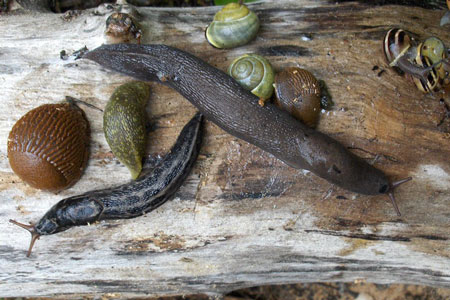 ... ...
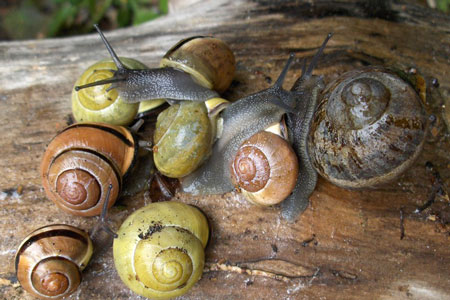
|
It
was more difficult to take photos of gastropods, than I thought. Two slugs
moved surprisingly fast in all directions. When
I had to load the accu, the other slug started also to move. I had
put the snails back in the bucket for an other photo and had released the
slugs on the compost heap.
Most gastropods are hermaphrodites, which means that each animal is both
male and female. When slugs have mated, both
participants will later lay hundreds of eggs.
Gastropods have a muscular foot which
is used for moving.
They secret a mucus or
slime on which they glide.
The brown slug is a Chocolate Arion, Large Red Slug
(Arion rufus).
This slug gives me the most trouble. It eats even the cactuses with sharp
spines. I see the large red slug also by day, when it is cloudy. On the
photo it is in rest. Slugs,
when attacked, can contract their body. The
grey with dark spots is a Great Grey Slug, Great slug, Grey slug,
Leopard slug ( Limax maxi sparrow)
The large slug is also a great grey slug. The green one is a Yellow
Slug (Limacus flavus)
|
|
The snails are
less aggressive (except the Cornu
aspersum) in our garden. The large shell is of a Brown Garden Snail, Common Garden Snail
(Cornu aspersum, Helix aspersa) That day, I only saw an empty shell. Strange, for mostly I find them
everywhere. Perhaps because the dryness at that moment.
This snail eat many young leaves. When conditions become too dry, the snail will retreat into its
shell and seal the entrance with a parchment-like barrier known as an
epiphragm, just like in the winter. Ten years.
The grove snail
or brown-lipped snail
(Cepaea nemoralis is
closely related to the white-lipped snail (Cepaea hortensis) and shares
the same habitat. The grove snail is larger and has a dark brown lip
to its shell in stead of a white lip.
But grove snails are polymorphic
in their shell colour and banding. White, yellow, pink, dark brown. Light
and dark bandings. The bandings vary in number. So it is difficult to
determine.
Control of Slugs and Snails: On and around the cactuses I use Escar-go.
It causes slugs and snails to stop feeding and
die within 3 to 6 days. It is not toxic and can
be used around pets and wildlife. I no longer plant hostas.
If I find gastropods on sensitive plants, I
put them on the compost heap. There they can eat.
Other sensitive plants in the garden: Bear's Breeches, Spiderwort
(Spiderwort
especially at the end of the bloom time), Golden groundsel, White coneflower
For these plants I use sometimes (but not often) esgar-go. I no
longer buy plants such as tagetes (or Marigolds) for the garden. I
let as much as possible nature goes its own way.
Enemies: thrushes,
beetles, moles, hedgehogs and mice.
|
Later I also took separate pictures of lugs and snails (some pictures years later).
|
 Greenhouse Slug (Ambigolimax valentianus). Family keelback slugs (Limacidae).
Greenhouse Slug (Ambigolimax valentianus). Family keelback slugs (Limacidae).
A moist shiny 5.5-8 cm long snail. Light brown with 2-3 dark lines, which are lighter in older snails. Slightly translucent. Eat green leaves and shoots. From Spain it has spread all over the world in the last 100 years. Photo
12-6-2023.
|
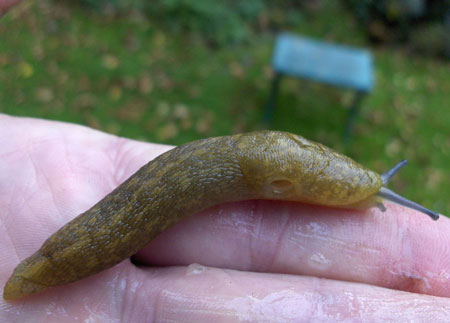 .. ..
 Yellow Slug ( Limacus flavus
synonym Limax flavus). Family keelback slugs (Limacidae).
Yellow Slug ( Limacus flavus
synonym Limax flavus). Family keelback slugs (Limacidae).
Yhis slug was not to determine from
the photo with the other slugs. So I have made some photos of an
other yellow slug. It is also a keeled slug, which has a yellow body with grey
mottling, and pale blue tentacles. Length:10 cm. This species is strongly
associated with human habitation, and is usually found in damp areas
such as cellars, kitchens, and gardens, at night. I find them in the
water meter pit. Photos 27-05-2007
|
|
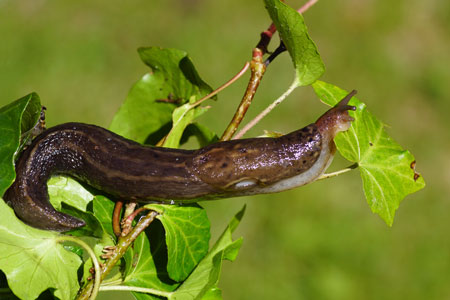 Great grey slug, leopard slug (Limax maximus). Family keelback slugs
(Limacidae).
Great grey slug, leopard slug (Limax maximus). Family keelback slugs
(Limacidae).
15 to 20 centimeters long. The color is gray to brown with usually a characteristic dark brown to black striped pattern on the part behind the mantle shield; the mantle shield itself is mottled. The stripes and spots pattern differs per slug and can also be completely absent. It is an omnivore (omnivore). From plants to other slugs. They can live for 2 to 3 years. Then they must overwinter in a frost-free place. Like in our water meter pit. Photo 30-5-2022.
|
|
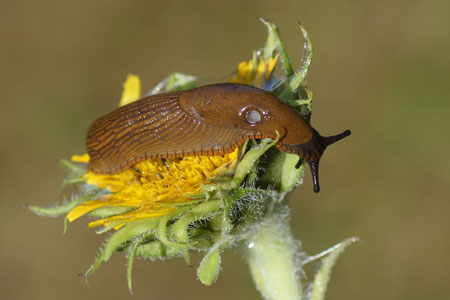 Red slug/Spanish slug (Arion rufus/vulgaris). Family roundback slugs
(Arionidae).
Red slug/Spanish slug (Arion rufus/vulgaris). Family roundback slugs
(Arionidae).
They are very similar. Of these two snails, Arion vulgaris is an exotic. Here
it ate our sunflower with some friends. It is the most voracious slug in our garden. Arion rufus is 10-15 centimeters long. sometimes longer. Variable in
color,,,. orange, red, brown, green-grey, black. Always a red border around the foot. Head with black lines. Photo 7/28/2022.
|
|
 Deroceras invadens. Family Agriolimacidae.
Deroceras invadens. Family Agriolimacidae.
A moist shiny slug up to 3.5 cm long. Grey brown, light to dark brown, sometimes almost black. Shield is often lighter. Eat live or decaying plant parts. Europe, America, South Africa, Australia, New Zealand. Native to Italy. Photo 13-11-2022.
|
|
 Garden
snail, common garden snail, brown garden snail (Cornu aspersum, syn. Cryptomphalus aspersus, Helix aspersa, Cantareus aspersus).
Family Helicidae. Garden
snail, common garden snail, brown garden snail (Cornu aspersum, syn. Cryptomphalus aspersus, Helix aspersa, Cantareus aspersus).
Family Helicidae.
Resembles the Helix pomatia, which is rare in the Netherlands. Yellow-brown shell with a few wider dark spiral bands, narrower lighter color bands and vertical (often slightly obliquely zigzagging) lighter and/or darker spots. Active in the dark, but also when it rains or has rained. This is the most voracious snail species in our garden. Unfortunately,
it likes young leaves. .Seedlings in our greenhouse can be gone after one night if he visited them.
|
|
 Grove snail, brown-lipped snail or Lemon snail (Cepaea nemoralis).
Family Helicidae. ..
Grove snail, brown-lipped snail or Lemon snail (Cepaea nemoralis).
Family Helicidae. ..
Slightly larger than the (yellower and with a white border at the opening) Cepaea hortensis. Usually pink to brown. Zero to five dark brown stripes following the whorls. All kinds of food. Dead leaves, but also living plants such as nettle and buttercup, dead animals such as snails and earthworms. These snails do not cause a nuisance in our garden. Photo 31-3-2021.
|
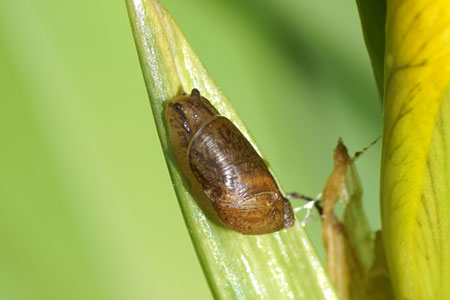 Pfeiffer's amber snail (Oxyloma elegans) or Oxyloma sarsii. Family ambersnails
(Succineidae).
Pfeiffer's amber snail (Oxyloma elegans) or Oxyloma sarsii. Family ambersnails
(Succineidae).
Like Succinea putris, it occurs in wet biotopes. Here on Yellow Flag in the pond. The two species cannot be distinguished from each other from a photo. Can grow up to 1.5 cm.
Photo 26-5-2024.
|
There are also many small snails in the garden. You
have to look under stones and leaves in the garden. They are mot harmful.
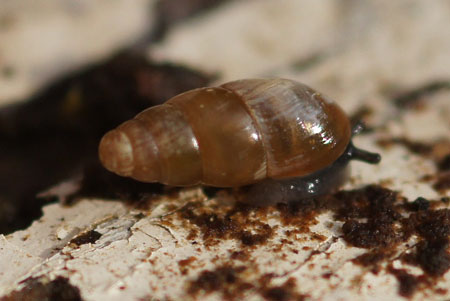 .. ..
 Cochlicopa. Maybe Cochlicopa lubrica. Family Cochlicopidae.
Cochlicopa. Maybe Cochlicopa lubrica. Family Cochlicopidae.
This snail I found under a piece of wood with a number of rounded
snails. The shell is 5 to 7 mm. (5 mm in the picture) Similar species are Cochlicopa lubricella
and Cochlicopa nitens.
It feeds on plant waste, fungi and sometimes fresh leaves.
Europe, North America. but now also in Australia, New Zealand and South Africa.
Photos 30-10-2010. Small photo: Cochlicopa and a Discus rotundatus.
|
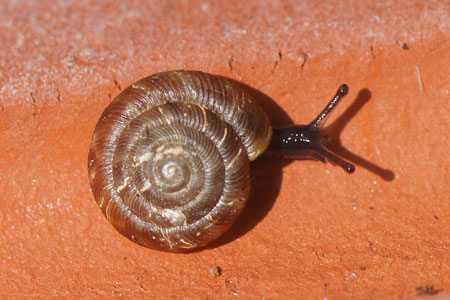 .. ..
 Rounded snail, Rotund Disc (Discus rotundatus).
Family Discidae.
Rounded snail, Rotund Disc (Discus rotundatus).
Family Discidae.
In the Netherlands this species is not to confuse with other species.
Characteristics: Shell pale yellowish brown with red-
brown stripes. The shell is about 6 mm.
The little snails eat vegetable matter and fungi.
I find the snails under stones, broken branches especially near the compos
heap.
Photos 30-8-2012. German: Gefleckte
Schüsselschnecke, Gefleckte
Knopfschnecke
|
 Girdled snail (Hygromia cinctella). Family Hygromiidae.
Girdled snail (Hygromia cinctella). Family Hygromiidae.
The shell of this snail varies in color from yellowish white to dark brown.
The shell is approximately 11 mm. Europe. Originally in south-west France up to Slovenia, but now common in many parts (such as the Netherlands).
Photo 7-11-2023.
|
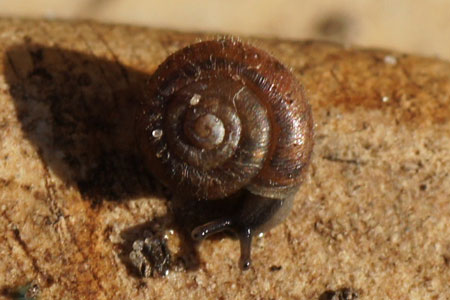 .. ..
 Hairy snail (Trochulus hispidus,
Trichia hispida). Family Hygromiidae.
Hairy snail (Trochulus hispidus,
Trichia hispida). Family Hygromiidae.
The shell of this snail has short hairs. Something you don't often see on
shells.
Shell about 6 mm.
Europe.
Photos 30-11-2011.
|
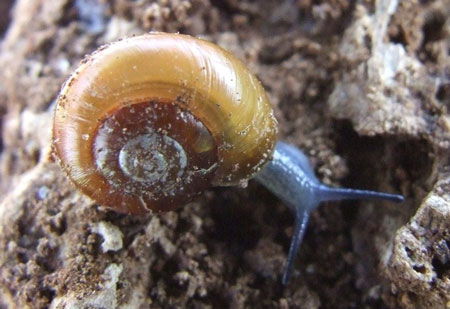 .. ..
 Rounded snail, Rotund Disc (Discus rotundatus). Familie
Oxychilidae.
Rounded snail, Rotund Disc (Discus rotundatus). Familie
Oxychilidae.
In the Netherlands this species is not to confuse with other species.
Characteristics: Shell pale yellowish brown with red-brown stripes. The shell is about 6 mm.
The little snails eat vegetable matter and fungi.
I find the snails under stones, broken branches especially near the compos
heap.
Thanks for determination Arjan de Groot en Tello Neckheim.
Photos 21-4-2008.
|
 This is Oscar. The cat of our
daughter. Sometimes it stays with us.
This is Oscar. The cat of our
daughter. Sometimes it stays with us. |
| Two photos of Oscar two years later. (May 2009) |
 On the bridge over the pond.
On the bridge over the pond. |
 At the edge of the pond.
At the edge of the pond.
As Oscar got older, he had trouble seeing and later went blind. Yet he still knew his way around the house and in the garden flawlessly when he stayed with us again. Unfortunately he passed away in 2020.
Here a
some photos on Flickr.
|
Collages of the woodlice, which I see in the garden. They are common species. Many more species are on the site
of Jan
van Duinen.
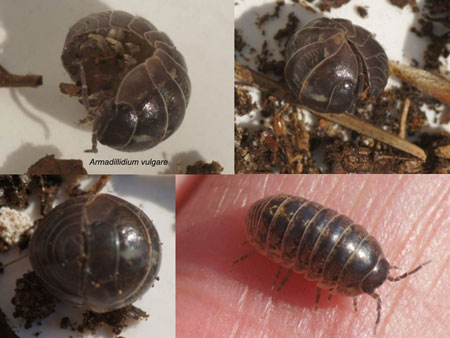 (Common) pill-bug, potato bug, (common) pill woodlouse, roly-poly, doodle bug, or carpenter
(Armadillidium vulgare). Family Armadillidiidae (pill bugs, roly polies or
doodle bugs).
(Common) pill-bug, potato bug, (common) pill woodlouse, roly-poly, doodle bug, or carpenter
(Armadillidium vulgare). Family Armadillidiidae (pill bugs, roly polies or
doodle bugs).
Usually dark grey, sometimes with irregularly arranged yellowish spots. The young ones are often spotted. From dry to wet environments. Length 18 mm. Looks like Armadillidium opacum and the young also on Armadillidium
nasatum. April 2018.
Members of this family can roll into a ball.
|
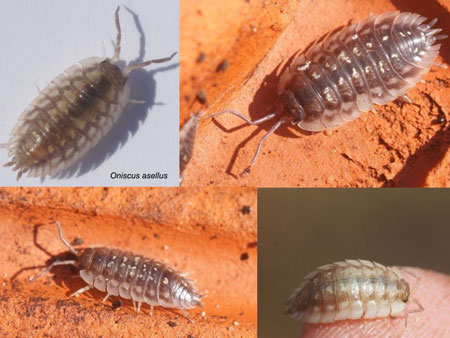 Common woodlouse ( Oniscus asellus). Family Oniscidae.
Common woodlouse ( Oniscus asellus). Family Oniscidae.
Wide body with a wide, light edge on the side and with sharp corners of the body segments. Shiny dark grey with brown and
grey-white spots. Often with two rows of yellow spots on the middle of the body. Length: 10-14 mm. From moderately moist to wet environments. March 2018. |
 Common striped woodlouse, fast woodlouse (Philoscia muscorum).
Family Philosciidae.
Common striped woodlouse, fast woodlouse (Philoscia muscorum).
Family Philosciidae.
Shiny brown, sometimes yellow or orange with regular rows of spots. Head dark, dark stripe on the back. The last five body segments are clearly narrower. Length: 6.5-9 mm. From dry to wet environments. March 2018. It runs faster than the other species.
|
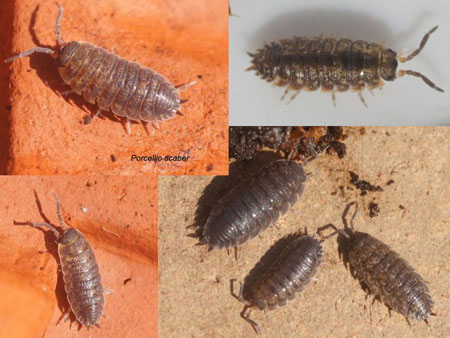 Common rough woodlouse, rough woodlouse (Porcellio scaber). Family
Porcellionidae.
Common rough woodlouse, rough woodlouse (Porcellio scaber). Family
Porcellionidae.
Mat grey, sometimes somewhat orange or yellow-green with irregularly arranged grey spots. Sometimes with a slightly lighter edge. Rough because of the small
tubercles. Length: 9-13.5 mm. Moderately moist to wet environment. March 2018.
|
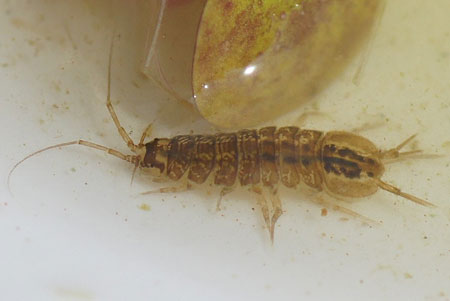 Freshwater crustacean (Asellus aquaticus). Family Asellidae (Isopod crustaceans).
Freshwater crustacean (Asellus aquaticus). Family Asellidae (Isopod crustaceans).
In the neighbor's pond. Brown and flat. Up to approximately 25 mm. In still to slow flowing water.
Photo 20-6-2014. |
My
photos on
Waarneming.
Links:
| American science project that maps biodiversity around the world.
www.inaturalist
|
|
|
America:
|
Austin bug collection. A photographic guide to the insects, spiders, and related arthropods found in Austin, Texas
by Valerie. |
|
Tom
Murray
Many, many, many insects and other species of America.
|
|
Bugguide.net
An online community of naturalists who enjoy learning about and sharing our observations of insects, spiders, and other related creatures.
|
|
Insectimages.org
Many images of insects in
America.
|
|
American
insects
The American Insects site is an on-line guide to 3,345 different insects from the Americas.
By Stephen Cresswell, Buckhannon, West Virginia
|
|
Latin
American insects This site is an add-on to our American Insects web site. |
Australia
|
Insects
I've photographed in Australia. |
|
Insects
of Tasmania. The majority of the photos in this site are taken by Tony Daley or Kristi
Ellingsen. |
Asia:
|
Papua-insects.nl
The insects of Papua Indonesia. Taxonomic and faunistic overviews. |
|
|
Germany:
|
Natur-in-nrw
of Axel Steiner. Text and image information on a variety of animals, plants, lichens and fungi of
Nordrhein-Westfalen. |
|
Naturraum
Stux of
Michael Stemmer. Detailed information of Michael about his garden,
but also about flora and fauna of Stuxes in Unkel, a small town south of Bonn. |
|
Ingrids Naturseiten
of Ingrid Altmann. Photos van insects and spiders.
|
|
Naturspaziergang
of Andreas Haselböck. Translated: A walk in nature. Andreas tells about everything you can find in the nature:
Plants, insects, arachnids, birds and other animals. |
France:
Nederlands /
Dutch
 
All subpages:
|
